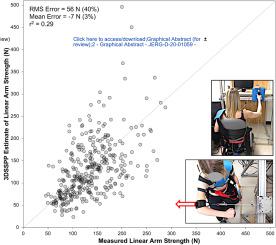Applied Ergonomics ( IF 3.2 ) Pub Date : 2021-03-30 , DOI: 10.1016/j.apergo.2021.103415 Andrew D Hall 1 , Nicholas J La Delfa 2 , Chris Loma 3 , Jim R Potvin 1

|
This study performed a direct comparison between empirically measured female linear arm strengths and those estimated with the 3D Static Strength Prediction Program (3DSSPP). Linear arm strengths were collected from 15 female participants, at four hand locations and six primary directions (n = 360), and then estimated with 3DSSPP incorporating each participant's own segment lengths, body masses and joint strengths, and the measured arm postures from each trial to optimize the accuracy of 3DSSPP. In spite of this, the errors in 3DSSPP's estimated arm strength values were very high (RMS error = 56.0 N and 40.4%) and poorly correlated (r2 = 29.2%) with measured strengths. These results seriously question the accuracy of 3DSSPP to estimate female linear arm strengths and percent capable values, for the range of conditions tested, likely due to the overly simplified assumptions made to estimate triaxial shoulder strength.
中文翻译:

测量的女性线性手臂力量与 3D 静态力量预测计划 (3DSSPP) 的估计值之间的比较
本研究对经验测量的女性线性手臂力量与使用 3D 静态力量预测程序 (3DSSPP) 估计的力量进行了直接比较。从 15 名女性参与者的四个手部位置和六个主要方向 (n = 360) 收集线性手臂力量,然后使用 3DSSPP 估计每个参与者自己的节段长度、体重和关节强度,以及每次试验中测量的手臂姿势优化 3DSSPP 的精度。尽管如此,3DSSPP 估计的臂力值的误差非常高(RMS 误差 = 56.0 N 和 40.4%)并且相关性较差(r 2 = 29.2%) 测量强度。这些结果严重质疑 3DSSPP 估计女性线性手臂力量和百分比能力值的准确性,对于测试的条件范围,可能是由于对三轴肩部力量的估计过于简化的假设。


























 京公网安备 11010802027423号
京公网安备 11010802027423号